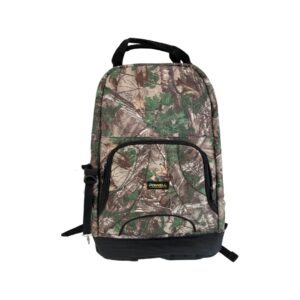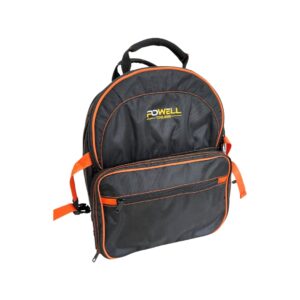- Regular Cleaning Routine: Establish a consistent cleaning schedule to remove dirt, debris, and residue from your tool backpack, ensuring it stays in optimal condition and prolongs its lifespan.
- Organized Storage: Keep tools and accessories neatly organized in designated compartments to prevent damage and make cleaning easier. Regularly inspect and reorganize to maintain order and accessibility.
- Protective Measures: Use protective liners or cases for sensitive tools, and consider water-resistant sprays or covers for the backpack to safeguard against spills, moisture, and harsh weather conditions.

Introduction
Your tool backpack is more than just a storage solution; it’s a crucial asset for your work. Keeping it clean ensures that your tools remain in good condition, prevents the spread of dirt and contaminants, and prolongs the lifespan of the backpack itself.
In this guide, we’ll delve into essential maintenance tips to help you keep your tool backpack in top condition. From regular cleaning routines to stain removal techniques and long-term care strategies, we’ll cover everything you need to know to ensure the longevity and functionality of your tool backpack.
Regular Cleaning Routine for Tool backpack
Importance of regular cleaning: Regular cleaning is vital for maintaining the integrity of your tool bag. Dust, dirt, and debris can accumulate over time, leading to wear and tear on the fabric and potential damage to your tools. By establishing a regular cleaning routine, you can prevent these issues and keep your backpack looking and functioning like new.
Step-by-step guide for cleaning your tool backpack: Start by emptying out your backpack and shaking out any loose dirt or debris. Then, use a soft brush or cloth to remove surface dust and dirt from the exterior of the backpack. Next, fill a basin or sink with warm water and mild detergent, and gently scrub the backpack with a sponge or soft brush. Rinse thoroughly with clean water and allow the backpack to air dry completely before re-stocking it with your tools.

Stain Removal Techniques for your Backpacks
Identifying common stains on tool backpacks: Tool backpacks are susceptible to various stains, including grease, oil, and dirt. Identifying the type of stain is crucial for determining the appropriate removal method. Grease and oil stains are common in workshop environments, while dirt and mud stains may occur during outdoor work.
Tips and methods for removing stains effectively: For grease and oil stains, sprinkle baking soda or cornstarch on the affected area and let it sit for a few hours to absorb the grease. Then, brush off the powder and treat the stain with a grease-fighting dish soap before washing as usual. For dirt and mud stains, allow the mud to dry completely before gently brushing it off with a soft brush. For stubborn stains, apply a mixture of vinegar and water or a commercial stain remover, then launder as usual.
Odor Elimination Strategies for Backpacks
A. Causes of odors in tool backpacks: Odors can develop in tool backpacks due to a variety of factors, including the accumulation of dirt and debris, exposure to moisture, and the presence of odorous tools or materials. Identifying the source of the odor is essential for effectively eliminating it.
B. Techniques for eliminating odors: To remove odors from your tool backpack, start by emptying it out and airing it out in a well-ventilated area. Next, sprinkle baking soda liberally inside the backpack and let it sit overnight to absorb any lingering odors. Alternatively, you can place activated charcoal or coffee grounds inside the backpack to help neutralize odors. For persistent odors, consider using a fabric deodorizer spray or placing scented sachets inside the backpack to keep it smelling fresh.
Storage and Organization
1. Proper storage practices to prevent damage: Proper storage is essential for maintaining the condition of your tool backpack and preventing damage to your tools. When not in use, store your backpack in a dry, clean environment away from direct sunlight and moisture. Avoid overloading the backpack with heavy tools, as this can put strain on the seams and zippers.
2. Organization tips for maintaining a clutter-free backpack: Keep your tool backpack organized by designating specific compartments for different types of tools and equipment. Utilize pouches, pockets, and dividers to keep smaller items organized and easily accessible. Regularly assess your tool inventory and remove any items that you no longer need or use to prevent overcrowding and maintain optimal organization.
Inspection and Repair
Importance of inspecting your backpack for damage: Regular inspections allow you to identify any signs of wear and tear on your tool backpack and address them before they worsen. Check the seams, zippers, and straps for any signs of fraying, tearing, or damage, and repair or replace any damaged components as needed.
Tips for repairing minor wear and tear issues: For minor damage such as loose threads or small tears, use a needle and thread to stitch up the affected area. Reinforce seams and stress points with extra stitching to prevent further damage. For larger tears or damage to zippers or straps, consider seeking professional repair services or replacing the affected components yourself.
Tips for Long-Term Care
Invest in quality materials: When purchasing a tool backpack, opt for high-quality materials that are durable and resistant to wear and tear. Look for backpacks made from heavy-duty nylon or polyester with reinforced stitching and robust hardware.
Follow manufacturer’s care instructions: Pay attention to any care instructions provided by the manufacturer and follow them carefully to ensure the longevity of your tool backpack. Avoid using harsh chemicals or abrasive cleaners that could damage the fabric or hardware.
Frequently Asked Questions (FAQ)
-
How often should I clean my tool backpack?
It’s recommended to clean your tool backpack regularly, ideally after each use or at least once a month, depending on how frequently you use it and the conditions it’s exposed to.
2. Can I machine wash my tool backpack?
While some tool backpacks may be machine washable, it’s best to check the manufacturer’s care instructions before attempting to wash it in a machine. In general, hand washing is gentler and less likely to cause damage.
3. How can I prevent mold and mildew growth in my tool backpack?
To prevent mold and mildew, ensure your tool backpack is completely dry before storing it, especially if it has been exposed to moisture. Consider using moisture-absorbing products such as silica gel packets or moisture-absorbing crystals inside the backpack to help control humidity levels.
4. What should I do if my tool backpack gets wet?
If your tool backpack gets wet, empty it out and allow it to air dry completely in a well-ventilated area away from direct sunlight. Avoid storing wet tools or equipment inside the backpack, as this can promote mold and mildew growth.
5. Can I customize my tool backpack to better suit my needs?
Yes, many tool backpacks feature customizable compartments and organizers that allow you to tailor the backpack to your specific tools and equipment. Consider investing in additional pouches, dividers, or accessories to maximize organization and functionality.
Related Article:
Waterproof Tool Backpacks: Protecting Your Tools in Any Weather Conditions
Tool Backpacks for HVAC Technicians: Must-Have Features and Recommendations
Conclusion
Maintaining a clean and organized tool backpack is essential for the longevity of your tools and the efficiency of your work. By establishing a regular cleaning routine, keeping your tools organized, and taking protective measures, you can ensure that your tool backpack remains in top condition. A well-maintained tool backpack not only enhances your productivity but also reflects your professionalism. Invest the time and effort into proper maintenance, and you’ll enjoy the benefits of a reliable and efficient tool-carrying solution for years to come.
For a wide selection of high-quality tool backpacks designed to meet the needs of HVAC technicians and other professionals, visit Tools Bag. Explore our range of durable and versatile backpacks to find the perfect solution for your tool storage needs.
